The .223 Remington and .308 Winchester are both great cartridges in certain applications, but each have different strengths and weaknesses. So, the question central to the 223 vs 308 debate remains: which one is better for you?
Few topics seem to be as hotly contested as the 223 vs 308 debate. Indeed, that dispute spans over five decades and really took off during the mid-1960s when the US Military started replacing the M-14 with the M-16 service rifle.
While there is a small overlap in their capabilities, the two cartridges represent two vastly different ways of thinking: smaller, lighter, and faster vs bigger, heavier, and slower. This is part of the reason why each have such a dedicated and loyal following and why the 223 vs 308 debate continues to rage on after so many years.
In this post, I’m going to investigate the 223 vs 308 debate in detail and provide some insight into which cartridge is better suited for various situations.
Before we get started, I have two administrative notes for you.
First, though the .223 Remington and the 5.56x45mm NATO are technically different cartridges (the same goes for the .308 Winchester and the 7.62x51mm NATO rounds), the practical difference in performance between the .223 vs 5.56 (and the .308 vs 7.62) is very small and doesn’t make any difference for the purposes of this article. Use extreme caution when attempting to interchange the .223 Remington or .308 Winchester with their NATO cousins though.
For a more detailed discussion on the differences between the .223 Remington and 5.56x45mm NATO cartridges, read this article:
5.56x45mm NATO vs .223 Remington
Second, some of the links below are affiliate links. This means I will earn a small commission (at no extra cost to you) if you make a purchase. This helps support the blog and allows me to continue to create free content that’s useful to hunters like yourself. Thanks for your support.
Finally, I recorded an entire podcast episode on this exact subject. If you’d rather listen than read, click the appropriate link below to listen to this episode on your preferred podcasting service.
223 Remington vs 308 Winchester Podcast
Apple | Google | iHeart | Pandora | Spotify
223 vs 308: Similarities
First, lets start with the areas where the .223 Remington and .308 Winchester are similar.
Both cartridges got their start in the time period between World War II and the Vietnam War when the US Military was searching for a replacement to the venerable M-1 Garand rifle and .30-06 Springfield cartridge. Each cartridge has also been used extensively by military forces all over the world, including the US Military and the armed forces of many other NATO members.
For this reason, there’s a pretty good supply of surplus military ammo for both cartridges (though .308/7.62 surplus ammunition is not as common or inexpensive as it was 20-30 years ago).
The two cartridges also have great reputations for accuracy and are very popular among competition shooters all over the world. Shooters, hunters, and preppers use both cartridges extensively, so just about every major gun manufacturer produces rifles chambered in .223 Remington and .308 Winchester.
Indeed, the .223 Remington and .308 Winchester rank right up there with the .270 Winchester and .30-06 Springfield at the top of the list of the most popular centerfire rifle cartridges in the United States. Not surprisingly, users of these cartridges have plenty of choices when it comes to good quality guns as well as surplus military, target shooting, and hunting ammo.
So, we’ve covered how the .223 and .308 are similar, but how are they different?
223 vs 308: Cartridge Sizes
Though the US Military was pleased with the performance of M-1 Garand and the .30-06 during World War II, American military leaders started looking for a new rifle and cartridge in the years following the war. Specifically, they wanted a rifle capable of fully automatic fire and with a detachable magazine along the lines of the German StG-44 or the Soviet AK-47. At the end of a long and contentious design and selection process, the Army eventually picked the M-14 rifle chambered in the new 7.62x51mm cartridge to replace the M-1 Garand.
The original M80 ball load for the 7.62x51mm NATO fired a .308″ 147 grain full metal jacket (FMJ) bullet at 2,750 feet per second (2,469 foot pounds of energy). This load had virtually the same ballistics as the original .30-06 Springfield load (150 grain bullet at 2,700 feet per second), but due to advances in powder technology, the 7.62x51mm cartridge achieved that same level of performance while using a much shorter case (51mm vs 63mm).
For a more detailed discussion on the .308 Winchester and how it compares to the .30-06 Springfield, read this article:
308 vs 30-06 vs 300 Win Mag: Which Cartridge Should You Be Hunting With?
During that timeframe, Winchester noticed serious commercial potential with the 7.62x51mm cartridge and rolled out the extremely similar .308 Winchester cartridge for the civilian hunting and shooting markets.
The .308 Winchester quickly caught on with civilian hunters and shooters who appreciated the efficiency, power, and accuracy of the cartridge. At the same time, the military appreciated those same characteristics in the 7.62x51mm and it gained widespread approval for its performance in designated marksman/sniper rifles as well as machineguns. On the other hand, the military was not pleased with the performance of the M-14 as the primary infantry service rifle and decided to move on to something new after just a few years.
For all the strengths of the M-14 and the 7.62x51mm NATO, leaders in the military wanted a lighter rifle and cartridge so Soldiers could carry more ammunition and more easily control the rifle when firing in fully automatic mode.
The military settled on the M-16 rifle and the high velocity 5.56x45mm cartridge and the US Air Force, Army, and Marine Corps adopted the new rifle and cartridge during the 1960s.
Derived from the .223 Remington (which was itself descended from the .222 Remington cartridge), the original M193 ball load for the 5.56x45mm cartridge fired a .224″ 55 grain full metal jacket bullet at 3,250 feet per second (1,290 foot pounds of energy).
Though they were initially well received by the military, M-16 and the 5.56x45mm cartridge had some major teething problems during the Vietnam War. Understandably, both (but the M-16 in particular) were much maligned by large numbers of men who had bad experiences with them while serving in Vietnam.
However, modifications to the rifle and the propellant used in the cartridge solved many of those issues and both remain in common use by military forces all over the world. Additionally, the military adopted a the M16A2 with a faster rifling twist rate (1:7 vs 1:12) and a new 5.56x45mm ball load (the M855) firing a 62 grain full metal jacket boat tail bullet at 3,025 fps during the 1980s. This load penetrated much better than the M193 load, but complaints about the terminal performance of the bullet from Soldiers eventually spurred the development of another ball load (the M855A1) during the Global War on Terror.
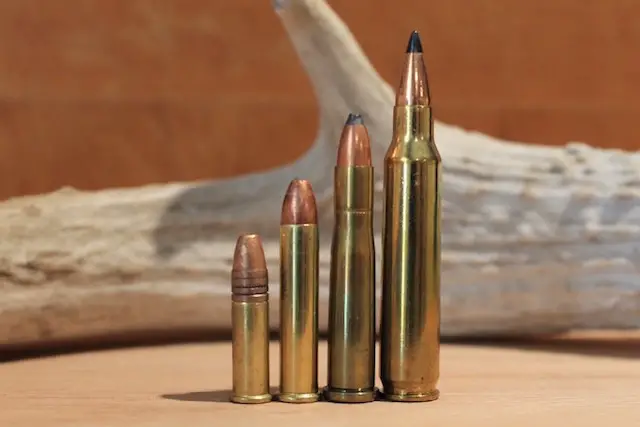
The M855A1 load uses a lead free 62 grain bullet made from copper alloy with a steel penetrator. It’s loaded to a higher pressure than the M855 load and is designed for optimum performance out of the short barreled M-4 carbines commonly used by the military these days. All in all, the M855A1 has been well received and has a reputation for being more accurate, penetrating barriers more effectively, and having better terminal performance than the old M193 and M855 ball ammunition.
To learn more about the 6.5 Grendel, 6.8 Remington SPC, and .300 AAC Blackout, which were also developed in an effort to improve upon the terminal performance of the 5.56x45mm cartridge, check out the articles below:
6.5 Grendel vs 6.5 Creedmoor: Which Is Right For You?
6.5 Grendel vs 308: Everything You Need To Know
6.8 SPC vs 6.5 Grendel: The Full Story
.300 Blackout vs 7.62×39: Everything You Need To Know
You can see the stark contrast between the .223 and .308 cartridges in the photo below. The .308 Winchester has a much longer case length (2.015″ vs 1.76″) and overall length (2.81″ vs 2.26″) than the .223 Rem. Heck, the .308 Winchester is so much larger that it can almost fit an entire .223 Remington cartridge inside its case.
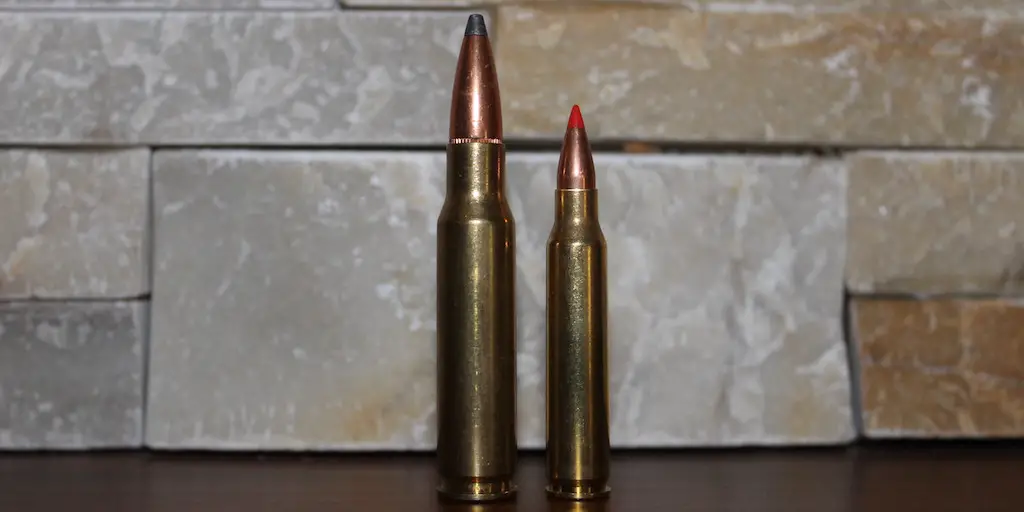
Additionally, the .308 Winchester has a larger (.473″ vs .378″) case diameter than the .223 Remington. Combined with the fact that the .308 Winchester uses a much longer case, it has significantly more case capacity than the .223 Remington.
Note: while the case capacity figures listed below do give a good indication of the differences between the two cartridges, exact case capacities vary slightly according to the brand of brass used.
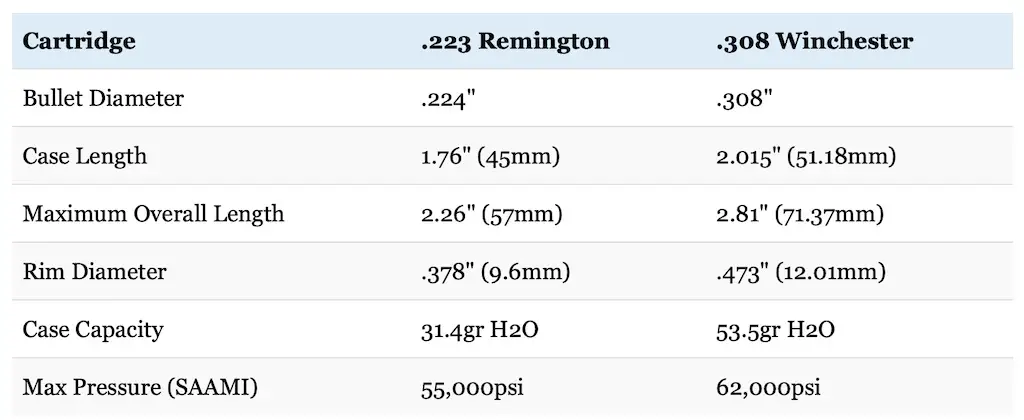
223 vs 308 Ballistics
Notwithstanding the significant advantage the .308 Winchester has in case capacity, the .223 Remington has a big advantage in muzzle velocity and trajectory because it shoots considerably smaller and lighter bullets.
For instance, the vast majority of .223 Remington factory loads shoot bullets in the 35-90 grain range. Of these, 55 grain, 62 grain, and to a lesser extent, 77 grain bullet weights are by far the most common. On the other hand, most .308 Winchester factory loads use bullets in the 110-180 grain range. 150 grain, 165 grain, 168 grain, and 180 grain bullets are the most popular.
The table below compares the 55gr Winchester Varmint X (.255 BC), 62gr Barnes TSX BT (.314 BC), and 64gr Winchester Deer Season XP (.282 BC) loads in .223 Remington to 150gr Winchester Deer Season XP (.392 BC), 168gr Barnes TTSX (.470 BC), and 180gr Winchester Power Point (.382 BC) loads in .308 Winchester, there is a pretty sizable difference in the ballistics and kinetic energy of each cartridge.
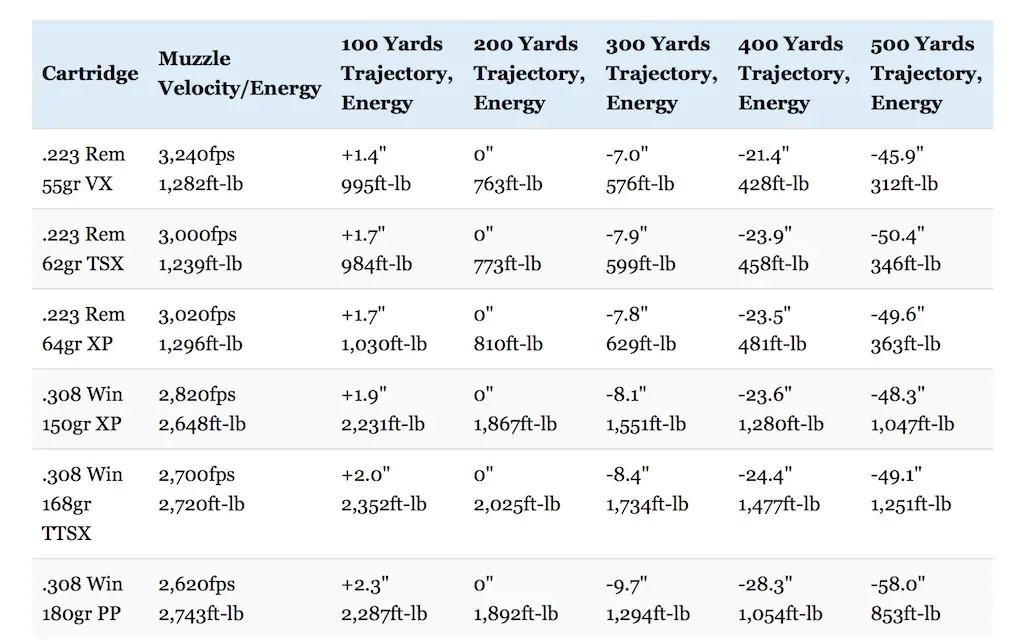
For the most part, the .223 Remington has a flatter trajectory than the .308 Winchester out to 500 yards. However, the typical .308 Winchester load has more than twice the muzzle energy than the typical .223 Remington load.
Additionally, the heavier bullets with a higher ballistic coefficient used by the .308 Winchester retain more energy and velocity than the lightweight .223 bullets. Indeed, the typical .308 Winchester load still has as much or more energy remaining at 400-500 yards as the .223 Remington does at the muzzle. Those same characteristics make the .308 Winchester a much better choice for long range shooting.
That being said, not only does the .223 Rem have a flatter trajectory at short range, but it recoils a whole lot less than the .308 Winchester. When fired from the exact same rifle, the .223 Remington has less than 1/5 the recoil of the .308 Winchester. That’s really saying something too because the .308 Winchester has a relatively mild recoil itself. However, recoil from the .223 is virtually non-existant.
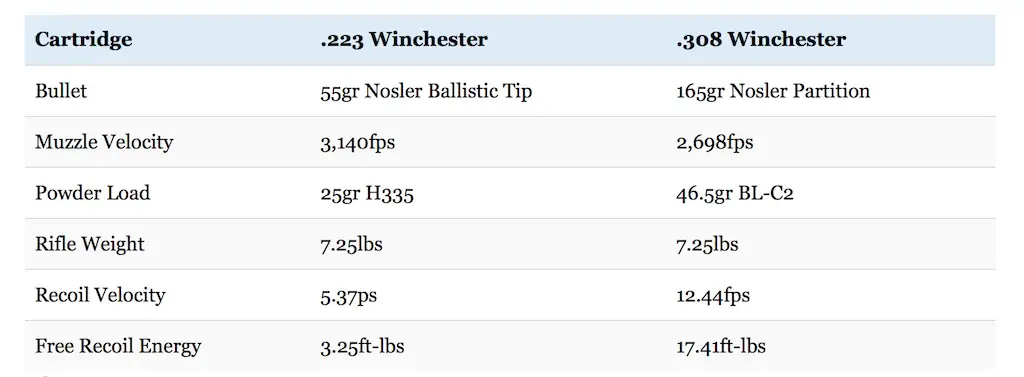
Felt recoil will vary from shooter to shooter and rifle to rifle, but free recoil energy is still a useful way to compare the two cartridges.
Both cartridges are also extremely accurate and have seen extensive use in the hands of military and police snipers and designated marksmen as well as competition shooters. There are also a number of quality choices for match ammunition for both cartridges. Though it’s difficult to choose a winner when it comes to accuracy of the 223 vs 308 at short range, the .308 Winchester has longer effective range and big advantage at ranges past 500 yards because those heavier bullets retain more energy and are less susceptible to wind drift.
.223 Ballistics
The .223 Remington shoots small diameter, lightweight bullets at a very high velocity. Performance varies with barrel length, but typical .223 ballistics with factory ammo are a 50gr bullet at 3,345fps (1,242 ft-lbs), a 55gr bullet at 3,240fps (1,282 ft-lbs), and a 62gr bullet at 3,100fps (1,323 ft-lbs).
.308 Ballistics
Typical .308 ballistics with factory ammo are a 150gr bullet at 2,820fps (2,648 ft-lbs), a 165gr bullet at 2,700fps (2,670 ft-lbs), and a 180gr bullet at 2,570fps (2,640 ft-lbs). The .308 Winchester is a good all-around big game hunting cartridge with moderate recoil and ample power for most species.
223 vs 308: Ammunition Selection
Since the .223 Remington and .308 Winchester are such popular cartridges, virtually every ammunition manufacturer of note like Barnes, Black Hills, Browning, Federal Premium, Fiocchi, Hornady, Nosler, PPU, Remington, Swift, Weatherby, and Winchester (just to name a few) produce a wide variety of ammo for both cartridges.
Some bullets (like the Hornady GMX and the Nosler E-Tip) are available for both cartridges. However, lightly constructed bullets designed for varmint hunting (like the Hornady V-Max, Nosler Varmageddon, and Winchester Varmint X) are most common with the .223 Remington. On the other hand, bullets designed for big game hunting (like the Nosler Partition and Swift Scirocco/A-Frame) are most common for the .308 Winchester.
Of course, this is all in addition to the large quantity of full metal jacket military surplus ammunition for both cartridges that’s currently available.
Prices and availability for each cartridge vary from region to region, but ammunition for both cartridges is widely available. Generally speaking, .223 Remington ammunition is less expensive than .308 Winchester ammunition.
BUY SOME GREAT 223 REMINGTON AMMO HERE
BUY SOME QUALITY 308 WINCHESTER AMMO HERE
If you’d like to learn more about some of the best hunting ammunition choices for the 223 Remington and 308 Winchester, read these articles:
Best 223 Ammo For Hunting Deer, Hogs, And Other Big Game
Best 308 Ammo For Hunting Deer, Elk, Feral Hogs, & Other Game
If you’re into hand loading, then you’re also in luck because reloading components for both cartridges are widely available. There are also lots of good quality FMJ, hollow point, and soft point .224 and .308 caliber bullets to choose from, so you shouldn’t have much trouble working up a custom load that shoots very accurately in your chosen rifle.
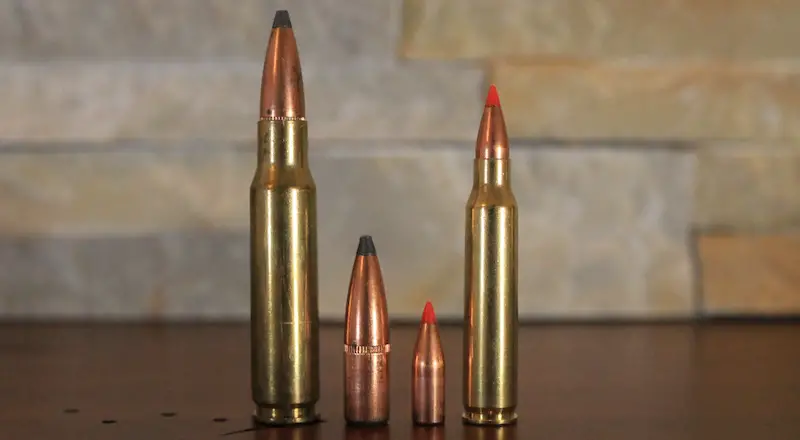
223 vs 308: Rifle Selection
Just like with ammunition, there are lots and lots of semi-automatic, pump, and bolt action rifles chambered in .223 Remington and .308 Winchester to choose from and virtually every firearms manufacturer produces rifles chambered in both cartridges.
Due in part to their military roots, there are a number of semi-automatic rifles available chambered in both cartridges. In particular, AR-15 style rifles are very popular with the .223 Remington. The .308 Winchester is also available in semi-automatic AR-platforms like the Remington R-25 as well as rifles like the AR-10, the FN FAL, and the Springfield M1A (the civilian version of the M-14).
Of course, both cartridges are available in a number of bolt action hunting rifles like the Remington Model 700, Ruger American, M77 Hawkeye, and Scout, Savage 11/111, and the Weatherby Mark Vanguard.
BUY AN EXCELLENT 223 REMINGTON HUNTING RIFLE HERE
BUY A GREAT 308 WINCHESTER HUNTING RIFLE HERE
223 vs 308: Which Is Right For You?
The .308 Winchester is one of the best big game hunting cartridges around and it holds a clear advantage over the .223 Remington when it comes to hunting medium to large sized game. Truth be told, the .223 Remington is still just a borderline big game hunting round (at best) and can’t hold a candle to the .308 Winchester in that regard.
For that reason, the .223 Remington isn’t a legal deer hunting cartridge in many states.
That being said, the advent of better quality bullets has made the .223 Remington a much more effective big game hunting than it used to be. Since the light recoil of the cartridge also makes follow-up shots a lot easier, the .223 Remington is a very popular cartridge for hunting situations that require a lot of shooting, like feral hog control. When using a quality bullet like the Hornady GMX, it will really do a number on all but the biggest hogs.
If we’re really being honest with ourselves though, the two cartridges are best suited for radically different tasks: the .223 Remington for varmint and pest control and the .308 Winchester for big game hunting.
The flat trajectory and lightly constructed bullets most common with the .223 Remington make it great for taking shots at small, thin skinned animals like prairie dogs, bobcats, and coyotes.
On the other hand, since it shoots heavier, larger diameter, and generally much better constructed bullets, the .308 Winchester has a clear advantage when hunting larger species like deer, caribou, elk, and red stag. The .308 is a little on the light side for moose and grizzly/brown bear, but it will work in a pinch with proper shot placement. All things considered, it’s an excellent all-around cartridge for big game hunting in New Zealand, Africa, or North America.
Though the .308 Winchester does have more stopping power, both cartridges are well suited for home or self defense, particularly due to the availability of well designed semi-automatic rifles and large amounts of high quality ammunition at a reasonable price.
Do you want a cartridge well suited for hunting big game like deer, elk, or bears? Get a .308 Winchester since it’s much more powerful and there are lots of great ammunition choices designed for that sort of hunting.
Are you looking for a cartridge to hunt predators and small game animals with? Both will work, but the .223 Remington is the better choice here because it has a flatter trajectory, ammunition is cheaper, and there are many types of .223 ammo specifically designed for predator and varmint hunting.
Are you very sensitive to recoil? Go with the .223 Remington as the recoil that cartridge produces is virtually non-existant.
As I’ve stated before: the .223 Remington and .308 Winchester are both solid rifle cartridges. However, since the difference between them (223 vs 308) is pretty big in certain respects, each cartridge is better suited to specific situations than the other.
For a more detailed discussion on the .308 Winchester and how it compares to the 6.5 Creedmoor cartridge as well as how the .223 Remington compares to some other popular high velocity cartridges, read the articles below:
22-250 vs 223 vs 204 Ruger vs 220 Swift: Clash Of The Speed Demons
224 Valkyrie: Should You Buy One?
Enjoy this article about the 223 vs 308 debate? Please share it with your friends on Facebook and Twitter.
Nosler provided the load data used to compare trajectory and recoil for the cartridges (here and here). Ballistic data for the 5.56x45mm and 7.62x51mm cartridges were obtained from Inetres. Cartridge case capacities were obtained from Chuck Hawks. The Lyman 50th Edition (p139-143 & 241-245) and Hornady 10th Edition (p160-178, 474-488) reloading manuals were also used as references for this article. Maximum pressure obtained from SAAMI (p24 and p31). I used the Hornady Ballistic calculator and Handloads.com to compare wind drift, the range each bullet goes subsonic, and recoil for the cartridges.
Make sure you subscribe to The Big Game Hunting Podcast and follow The Big Game Hunting Blog on Facebook, Instagram, Twitter, and YouTube.
NEXT: BEST 6.5 CREEDMOOR AMMO FOR HUNTING ELK, DEER, & OTHER BIG GAME
John McAdams is a proficient blogger, experienced shooter, and long time hunter who has pursued big game in 8 different countries on 3 separate continents. John graduated from the United States Military Academy at West Point and is a veteran of combat tours with the US Army in Iraq & Afghanistan. In addition to founding and writing for The Big Game Hunting Blog, John has written for outdoor publications like Bear Hunting Magazine, The Texas State Rifle Association newsletter, Texas Wildlife Magazine, & Wide Open Spaces. Learn more about John here, read some of John’s most popular articles, and be sure to subscribe to his show: the Big Game Hunting Podcast.


Great article! Thank you for your thoughtful insight. Really helped me make up my mind…I need both
Just took delivery of Czech .223 today and now, like previous person, figure that I need. .308 as well.
Not sure how police will feel about that here in Australia. Need to work up a story.
Great article. I want the .308 for the power but the .223 for the cost to run and lack of recoil. Is there another option?
The 7.62×39 and .300 Blackout split the different to a small degree, but (like always), there’s always some sort of trade-off.
Read the articles below for more information:
https://thebiggamehuntingblog.com/223-556-vs-762×39/
https://thebiggamehuntingblog.com/556-vs-300-blackout-vs-308-winchester/
Brilliant review. Thank you. .243 vs 308, anyone?
Glad you enjoyed it Richard!
243 vs 308? No problem. Check out the article below.
https://thebiggamehuntingblog.com/243-vs-308-vs-7mm-08/
My first bolt rifle i owned was a remington 700 in 308.. omg. The recoil was so horrible that it made me hate shooting target papers. Coming from 22LR, handling the 308 was scary like sht…. Not only that, the ammo in 2021 is so freaking expensive that my 308 became a piece of collectible device hidden in my locked closet. 2$ per round man.. each pack cost between $25-$40 .. i make only $20/h.
Thats nearly half of my daily income to shoot 20 rounds. Lol
I went back to 22LR. Later i bought a 17 hmr and a 223.. my 17hmr is for sale.
117 hmr are much better than 22Lr in term of accuracy but their bullets are 4 times the price of a 22LR. The 223 is slightly more expensive than the 17 hmr but atleast you can reload your own. If you are a target paper shooter and want more than a 22 LR i say go 223 for special occasions but keep your 22LR when your finance is low lollol